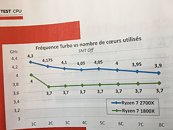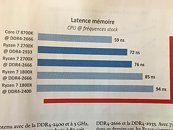Monday, March 26th 2018

Canard PC Hardware's AMD Ryzen 7 2700X Printed Review is Out
The latest issue of Canard PC Hardware magazine came with a pretty detailed review of the AMD Ryzen 7 2700X processor. A Reddit member was kind enough to take photographs of the review and uploaded them to Reddit. The French publication's charts revealed the Ryzen 2700X's prowess in synthetic benchmarks. The processor comfortably sat at the top of the chart overcoming the previous Ryzen 7 1800X flagship processor by 14% and the Intel Core i7-8700K by 15%. Canard PC also compared Summit Ridge to Pinnacle Ridge in terms of Turbo frequency and memory latency. It wasn't a complete surprised that Pinnacle Ridge showed significant improvements over the previous architecture. However, the Ryzen 7 2700X wasn't able to close the gap with its rival. When using the exact DDR4-2666 memory, the Ryzen 7 2700X was 17 ns slower than the Intel Core i7-8700K. As for power consumption, the Ryzen 7 2700X consumed 13.2W more than the Ryzen 7 1800X.
Canard PC tested gaming performance using a NVIDIA GeForce GTX 1080 Ti graphics card at the 1440p resolution. While we saw the Ryzen 7 2700X's dominance in synthetic benchmarks, its real-world gaming performance was far less impressive. Although the Ryzen 7 2700X's performed 4% better than the Ryzen 7 1800X sibling, the processor fell behind the likes of the Intel Core i5-8400 by 1.3% and the more powerful Intel Core i7-8700K by up to 14.3%. One important detail to note about Canard PC's review is that they conducted their tests on an A320 motherboard. They claimed that X470 is practically identical to X370 except for a few cosmetic changes. Given that the A320 chipset doesn't support AMD's XFR 2 and Precision Boost Overdrive technologies, we think that it's possible that the Ryzen 7 2700X might perform better on a motherboard with a proper X470 chipset.
Source:
Reddit
Canard PC tested gaming performance using a NVIDIA GeForce GTX 1080 Ti graphics card at the 1440p resolution. While we saw the Ryzen 7 2700X's dominance in synthetic benchmarks, its real-world gaming performance was far less impressive. Although the Ryzen 7 2700X's performed 4% better than the Ryzen 7 1800X sibling, the processor fell behind the likes of the Intel Core i5-8400 by 1.3% and the more powerful Intel Core i7-8700K by up to 14.3%. One important detail to note about Canard PC's review is that they conducted their tests on an A320 motherboard. They claimed that X470 is practically identical to X370 except for a few cosmetic changes. Given that the A320 chipset doesn't support AMD's XFR 2 and Precision Boost Overdrive technologies, we think that it's possible that the Ryzen 7 2700X might perform better on a motherboard with a proper X470 chipset.





21 Comments on Canard PC Hardware's AMD Ryzen 7 2700X Printed Review is Out
CanardPC tested Ryzen 7 2700X, Ryzen 5 2600X and Ryzen 5 2600 on a mainboard with A320 chipset. The processors are said to have been taken out of series production. The CPUs in the editorial team of ComputerBase already correspond to the series, they were manufactured in the first two weeks of the calendar this year.
With the choice of the chipset the two X-processors in the test of CanardPC were denied to make use of the two new turbo mechanisms XFR 2 Enhanced and Precision Boost Overdrive , which will give it only for X470 and B450. The even finer Turbo Precision Boost 2 offer, however, the chipsets of the first generation, the current information, the manufacturers are all made by BIOS update fit for Ryzen 2000.
ComputerBase is for a in the editorial already arrived motherboard with X470 chipset but no final BIOS before. Influences on the speed through further updates, even for the older platforms, are therefore not excluded. In the first generation of Ryzen, a new microcode that AMD released just days before the release of the final test had brought significant performance improvements
Compared to its predecessor on the same motherboard with A320 chipset, CanardPC has identified slightly more than three percentage points advantage in games and 15 percent advantage in applications for the Ryzen 7 2700X compared to the Ryzen 7 1800X. The 1st generation Ryzen was tested with DDR4-2666, the second generation with DDR4-2933. However, the magazine currently does not provide information on other settings.
In addition to higher clock speeds and the finer graded Turbo, which was considered almost guaranteed for weeks, even lower memory latencies to help the new Ryzen to more power in games. The advantages shown by CanardPC in games appear to ComputerBase against this background however as small. On Reddit is also already much criticism for the selection of games. The power consumption should be increased under full load and not only in the top model, whose TDP will officially rise. However, these results could also be dependent on the platform and its level of development.
In addition to technical question marks, the item from CanardPC also adheres to a detail from the pre-test to the first generation Ryzen from last year. In this the editors had hidden the note "ZenOC @ Air = 5G". This prophecy proved to be incorrect in the end. .
translate.google.com/translate?hl=en&sl=auto&tl=en&u=https%3A%2F%2Fwww.computerbase.de%2F2018-03%2Famd-ryzen-2000-preview%2F
Then why not test it on a X370... You would have thought that a respectable magazine/site like Canard would have at least a single X370 board laying around from previous tests.
Nothing new. Zen2 next year will do.
Cause VRMs on such entry-level boards tend to be bottom of the barrel in terms of quantity, quality and cooling.
It will work for sure (as shown in the review), but will the CPU work at 100% of it's capability.
Luckily ComputerBase has the same chips and X470 MB with preproduction bios.
The next real changes will be in Zen 2.
2011 - Sandy Bridge / Sandy Bridge-E - New architecture, with AVX
2012 - Ivy Bridge / Ivy Bridge-E - Refresh with minor tweaks of memory controller, and node shrink
2013 - Haswell / Haswell-E - New architecture
2014 - Haswell "refresh" - partial refresh of lineup (no changes)
2014/2015 - Broadwell / Broadwell-E - Partial refresh (node shrink)
2015 - Skylake - New architecture
2016/2017 - Kaby Lake - Refresh (no changes)
2017 - Skylake-X - Enterprise/high-end version of Skylake, with AVX-512, cache hierarchy redesign.
2017 - Coffee Lake - Refresh, core count increase
2018(pending) - Cannon Lake - Partial refresh (shrink)
2018(pending) - Cascade Lake-X - ENterprise/high-end refresh.
2018/2019(?) - Ice Lake - New architecture
The last major change was Sandy Bridge, but they have not been doing nothing. Especially Skylake-X is a massive improvement for vectorized workloads.You are mixing instruction set architectures with CPU architectures (known as implementations). x86 is fourty years old, BTW. None of the current x86 implementations are CISC processors, but in fact RISC implementations of x86. At the moment the legacy support for x86 is making up less than 1% of the die space. Whenever people complain about x86 I always ask them what the brilliant alternative is. ARM? No, it wouldn't scale beyond x86. Power or Itanium? No, they have already failed. There are no immediate successors on the horizon.
None of the current scaling walls are x86 related. The primary one is branching/cache misses, bottlenecked by DRAM latency, etc. Clock scaling is another major wall, a slightly more simple architecture will only scale a few percent further. New materials will be needed to scale clocks any significantly further.
Some areas with room for substantial improvement:
- Superscalar scaling: More ALUs, FPUs and/or execution ports. (e.g. if Intel added 3-4 more ALUs and 2 more FPUs, they could boost IPC by ~50%)
- Larger instruction window: Increase the CPU's ability to exploit instruction level and data level parallelism.
- Vector instructions: More vector units and bringing AVX-512 to more consumer platforms.
etc.
AMD still have a long way to go before they are on-par with Intel's front-end. They do have more ALUs and more execution ports than Intel, but Intel are better at keeping their resources fed.
x86 are here to stay for many years to come. But when it finally will be replaced it wouldn't be because of it's age, but because there is something significantly better.
Little do these people who think this way know that the Nehalem / Westmere arch was not far behind Sandy in real world performance when set at the same clock speed, but they were directly compared as 2.66 vs 3.33 / 3.4ghz Sandy chips. There is plenty of evidence around.